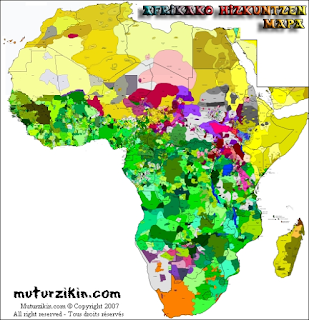 More on language maps with focus on Africa. This picks up a discussion begun in an earlier post, "Second most spoken languages in Africa."
More on language maps with focus on Africa. This picks up a discussion begun in an earlier post, "Second most spoken languages in Africa."One of the reactions (by several people on Twitter) to a set of maps and diagrams of the most spoken languages in the world published in the Washington Post's April 23 feature "The world’s languages, in 7 maps and charts"- in particular the diagram at right - was a question as to why Swahili was not included. After all, estimates of speakers of Swahili run as high as over 150 million.
African languages do tend to get overlooked in various contexts, but in this case it seems that the criteria used - "native language" - was the deciding factor. Swahili is widely used as a second or additional language (L2 being the common abbreviation) but relatively fewer people speak it as a first or native language (L1) - somewhere in the range of 15-50 million (more on such estimates below). This is not enough to make this chart, which deals only with L1s. The number of L1+L2 speakers of Swahili is in the 60-150 million range.
 The map/diagram at right was posted on Twitter as a reference in the above discussion. (Thanks to Prof. Calestous Juma of Harvard University for calling our attention to it.) This comes from an article entitled "International Mother Language Day 2014" on the elearning-africa.com site. However the figures given for "six of the most widely-spoken languages" clearly have to do not just with maternal language (L1) speakers, but also with L2 speakers.
The map/diagram at right was posted on Twitter as a reference in the above discussion. (Thanks to Prof. Calestous Juma of Harvard University for calling our attention to it.) This comes from an article entitled "International Mother Language Day 2014" on the elearning-africa.com site. However the figures given for "six of the most widely-spoken languages" clearly have to do not just with maternal language (L1) speakers, but also with L2 speakers.To elearning-africa.com's credit, the article notes the complexities involved in citing figures for African languages, including the L1 and L2 issue:
"[I]t is of course extremely difficult to count numbers of language speakers, especially when the data is vague. Should only first-language speakers be counted? But then, what about Kiswahili and Hausa, which have fewer native speakers but are used across wide geographical areas as trade languages? It is important to remember that any depiction of African languages, other than the most exhaustive study, will be a compromise at best."
The closest we have to an exhaustive study of numbers of African language speakers continentwide would be the figures compiled by Ethnolgue, though these are themselves often estimates and works in progress. Still, one could work with such figures - as well as other research on language use in specific parts of Africa - to outline the top most spoken languages at different geographic scales - continental, sub-regions, countries, and provincial. These could in turn be presented in map layers. The utility of such data would be in better informing development/extension projects and relief efforts (such as that against ebola recently in West Africa) in which communication, participation, and education are fundamental..
 |
| Source: Michigan State University African Studies Center, "Exploring Africa" (modified) |
- Updating to reflect the split of Sudan and South Sudan
- In some cases the languages appear to be listed in order of number of speakers, but in others not - it would help to do the former consistently.
- I corrected one of the language names for Guinea - "Futa Jalon" is not a language, but a region where Pular, a variety of Fula, is spoken.
- Also about Fula, the listing of "Fulfulde" and "Pulaar Fulfulde" from Mauritania through Guinea Bissau needs review/revision.
- For Ghana, Fante and Asante-Twi could be consolidated to Akan, and one of the northern languages could be listed.
- I removed "Hima" as a language of Rwanda and Burundi. It's a name (or dialect) of Nkore, which although related to Kinyarwanda/Kirundi, is a language of Uganda. In Rwanda and Burundi, Ethnologue considers it "an ethnic group (not a language) which speaks Rwanda or Rundi."
The latter maps of course focus only on African languages, and without reference to the Europhone languages used in many countries in official capacity and/or as lingua francas (L2s). Another adaptation, therefore, could be on the continental level, to list the top most spoken languages (L1+L2) per country, including all tongues.
This would bring us back to the map of "second most spoken languages" in Africa proposed by Olivet Nazarene University. A more detailed look at that effort will be the subject of the next posting.

3 comments:
May we use the image of the most-spoken languages map in Africa in a KoopaTV article, with credit and linking back to you?
Thank you, Ludwig, for your interest and request. Credit actually goes to eLearning Africa (as mentioned in the article above), which had it created on the occasion of International Mother Language Day 2014. Unfortunately, the page referenced above no longer appears on their site, although it can be retrieved on Archive.org (when I checked, however, the versions there did not include the graphic). Please feel free to link back to this Beyond Niamey page if you do use it (with credit of course to eLearning Africa).
Like other such language map images, it was reposted on social media. The late Prof. Calestous Juma's posting of it on Twitter in 2015 was where I first saw it.
Cool, thank you!
Post a Comment